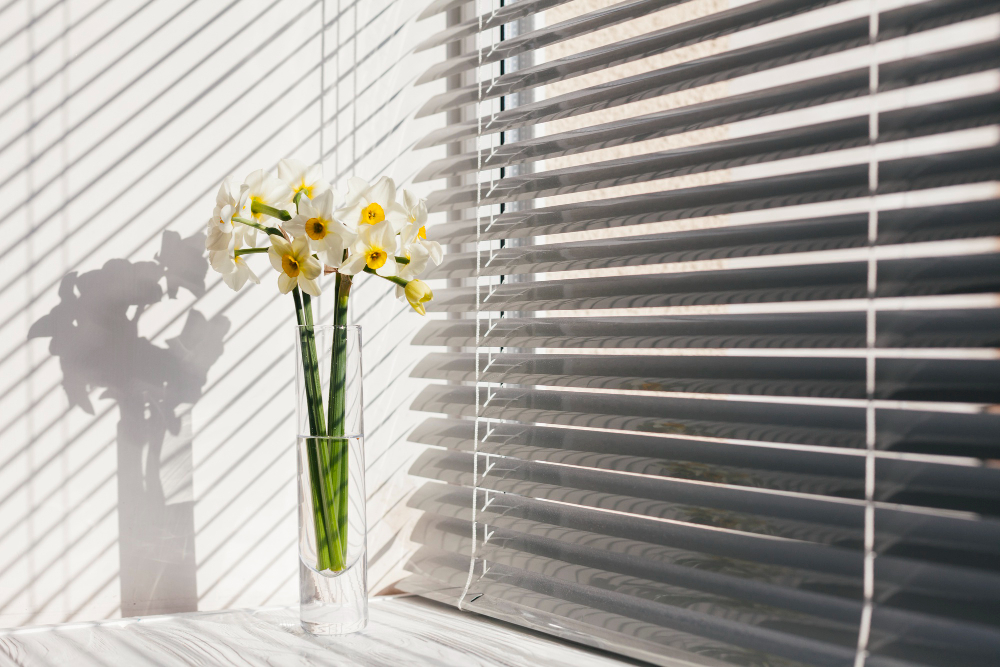Window blinds are not just a stylish addition to your home décor; they also provide privacy, control light, and even improve energy efficiency. However, blinds can accumulate dust, dirt, and stains over time, which may detract from their aesthetic appeal and functionality.

This guide will walk you through the best practices for cleaning and maintaining your window blinds so that they remain in top-notch condition for years to come.
Contents
Types of Window Blinds
Before we dive into cleaning and maintenance tips, it’s important to know the different types of window blinds available. The most common types include:
- Vertical blinds – These feature vertical slats that hang from a track and can be opened or closed by pulling on a cord.
- Horizontal blinds – As their name suggests, these blinds have horizontal slats that can be tilted to control the light entering a room.
- Roller blinds – These are made of fabric and use a rolling mechanism to open or close.
- Roman blinds – Similar to roller blinds, but instead of rolling up, they fold onto themselves when opened.
Cleaning Vertical Blinds
Vertical blinds are often the easiest to clean since their vertical slats don’t accumulate as much dust as horizontal blinds. You can either vacuum them using a brush attachment or wipe them down with a damp cloth. For tougher stains, use a mild detergent and warm water and gently scrub the affected area.
Cleaning Horizontal Blinds
Cleaning horizontal blinds can be more challenging as dust accumulates on both sides of the slats. One effective method is to use a microfiber cloth or duster and gently wipe each slat from top to bottom. You can also use a vacuum with a brush attachment, but be careful not to accidentally bend or break the slats.
For deeper cleaning, you can remove the blinds and soak them in a bathtub filled with warm water and mild detergent. Gently scrub the slats and then rinse them off before letting them air dry completely before rehanging.
Cleaning Roller Blinds
Roller blinds are easy to clean as well since they’re made of fabric. Simply use a damp cloth or sponge to wipe down each panel, being careful not to saturate the fabric. If your roller blinds are particularly dirty, you can also use a mild detergent and warm water to spot clean any stains. Just be sure to thoroughly rinse off the soap before letting them air dry.
Cleaning Roman Blinds
Roman blinds are a bit trickier to clean since they have folds that can accumulate dust and dirt. One method is to use a vacuum with a brush attachment to gently remove the dust from each fold. You can also use a lint roller or tape to pick up any remaining debris. For deeper cleaning, you can follow the same steps as horizontal blinds and remove them for soaking and scrubbing.
General Maintenance Tips
- Regularly dust or vacuum your blinds at least once a week to prevent the buildup of dirt and dust.
- Use a fabric or upholstery cleaner to spot-clean any tough stains or dirt on your blinds.
- Avoid using harsh chemicals or abrasive materials when cleaning your blinds, as they can cause damage.
- If you have pets, consider using an anti-static spray on your blinds to prevent pet hair from sticking to them.
- For wooden blinds, use a wood polish or conditioner to keep them looking shiny and new.
- Inspect the cords, tracks, and mechanisms of your blinds regularly for any signs of wear or damage. Replace them if necessary.
The Tools You’ll Need
- Microfiber cloth or duster
- Vacuum with a brush attachment
- Mild detergent
- Warm water
- Bathtub (for deeper cleaning)
- Fabric/upholstery cleaner (for tougher stains)
When Should You Clean Your Blinds?
It’s important to establish a regular cleaning schedule for your window blinds, but there are also certain occasions when you should give them some extra attention. These include:
- Moving into a new home – Before moving in, it’s a good idea to thoroughly clean your blinds to eliminate any dust or germs left behind by the previous owners.
- Seasonal cleaning – It’s recommended to give your blinds a deep cleaning at least twice a year, preferably at the beginning and end of each season. This will help keep them in top shape and prevent any buildup of dust and dirt.
- After renovations – If you’ve recently had any construction or renovation work done in your home, it’s a good idea to clean your blinds afterward to remove any dust or debris that may have accumulated on them.
Professional Cleaning or DIY?
While it’s possible to clean your window blinds yourself, you may want to consider hiring a professional cleaning service for a deep and thorough cleaning. This is especially recommended for older or delicate blinds that require special care.
Additionally, some professionals offer ultrasonic cleaning services, which use sound waves to remove dirt and grime from blinds without causing any damage.
When Should You Replace Your Blinds?
With proper cleaning and maintenance, your window blinds can last for many years. However, if you notice significant damage or wear and tear, it may be time to replace them. If this is what you need, it’s best to get in touch with professionals. Signs that your blinds need to be replaced include:
- Bent or broken slats – If you notice broken slats or slats that are bent out of shape, it may be time to replace them.
- Faded or discolored blinds – Over time, your blinds may become faded or discolored due to exposure to sunlight. This can affect the overall appearance of your home, and it might be a good idea to replace them if this occurs.
- Difficulty opening/closing – If you find it increasingly difficult to open or close your blinds, this could be a sign that the mechanisms are wearing out and need to be replaced.
- Visible damage – If your blinds have visible tears, holes, or other signs of damage, it’s likely time to replace them.
Conclusion
Regularly cleaning and maintaining your window blinds not only keeps them looking great but also extends their lifespan. By following these best practices, you can keep your blinds in top condition and enjoy the benefits they bring to your home for years.
Remember to establish a regular cleaning schedule, use the right tools and techniques, and consider professional cleaning or replacement when necessary.
